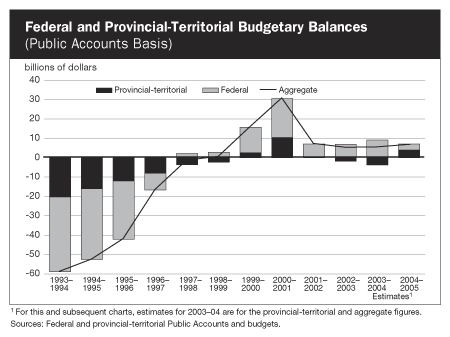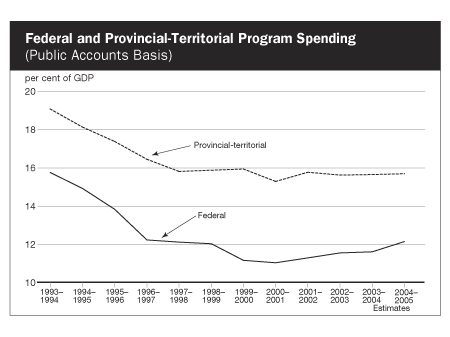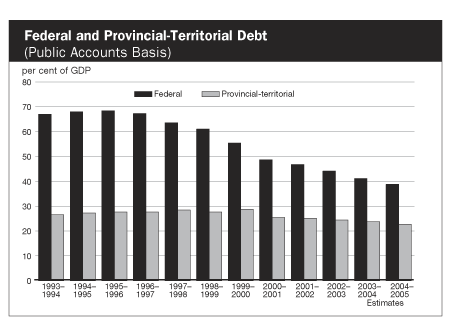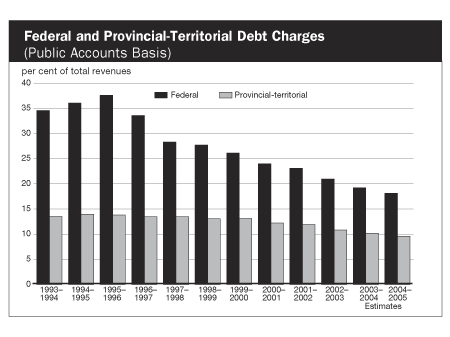![]()
Budget 2005 - Budget Plan
- Table of Contents - Previous
- Next -
Annex 1
Fiscal Performance of Canada's Federal-Provincial-Territorial Government Sector
Introduction
- This annex presents the fiscal situation of the aggregate federal-provincial-territorial government sector based on Public Accounts data, as published by the individual governments.[1]
- The federal-provincial-territorial governments combined are expected to record a $6-billion surplus in 200405 compared to a $5.3-billion surplus in 200304. This would be the seventh consecutive annual surplus. At the federal level, a surplus of $3 billion is estimated, down from $9.1 billion in 200304. The provincial-territorial sector is also expected to be in an aggregate surplus position of $3 billion[2] in 200405, the first surplus in three years.
- The federal revenue-to-GDP (gross domestic product) ratio should continue to decline in 200405, partly reflecting tax cuts announced in past budgets. In contrast, the provincial-territorial revenue-to-GDP ratio, which includes federal cash transfers, is expected to grow by 0.7 percentage points, in large part due to a rebound in provincial-territorial own-source revenues.
- In 200405 provincial-territorial program spending as a share of GDP should remain relatively unchanged from 200304, reflecting the fact that ongoing expenditure reviews and spending controls in many jurisdictions will offset spending increases in specific areas, especially health care. At the federal level, program spending as a share of GDP is expected to increase by 0.6 percentage points, due mainly to increased spending for health care, Equalization and Territorial Formula Financing.
- The provincial-territorial debt-to-GDP ratio is estimated to have fallen by 6.5 percentage points to 22.3 per cent in 200405 relative to its peak in 19992000. The federal debt-to-GDP ratio is estimated to have declined by 29.8 percentage points from its peak of 68.4 per cent in 199596. The higher federal debt burden means that the federal government continues to face much higher debt charges than the provincial-territorial sector. Nonetheless, the recent drop in the federal debt burden has contributed to maintaining lower interest rates, which benefits consumers, businesses and provincial-territorial governments.
In 200405 the aggregate federal-provincial-territorial government sector is expected to be in surplus for the seventh consecutive year

- Both the federal and provincial-territorial governments have contributed to the significant turnaround in Canadas fiscal situation over the last 10 years.
- The aggregate federal-provincial-territorial surplus is estimated at $5.3 billion for 200304, which represents a significant improvement from 199394, when the sector posted a $58.9-billion deficit.
- The commitment to balanced budgets or better at the federal level, combined with a significant improvement in the provincial-territorial fiscal outlook, particularly in light of recent increases in federal transfers, suggests that the federal-provincial-territorial sector will remain in a strong fiscal position in 200405, with an expected aggregate surplus of $6 billion.
The combined provincial-territorial sector budgetary balance is also expected to be in surplus in 200405
Provincial-Territorial Budgetary Balances
(Public Accounts Basis)
|
|
|||||||
| 199394 | 199900 | 200001 | 200102 | 200203 | 2003041 | 2004052 | |
|---|---|---|---|---|---|---|---|
|
|
|||||||
| (millions of dollars) | |||||||
| Newfoundland and Labrador | -341 | -269 | -350 | -468 | -644 | -914 | -708 |
| Prince Edward Island | -71 | -5 | -12 | -17 | -55 | -125 | -33 |
| Nova Scotia | -546 | -797 | 147 | 113 | 28 | 43 | 3 |
| New Brunswick | -266 | -30 | 43 | 79 | 1 | -14 | 54 |
| Quebec | -4,923 | 7 | 427 | 22 | -694 | -358 | 0 |
| Ontario | -11,202 | 668 | 1,902 | 375 | 117 | -5,483 | -2,168 |
| Manitoba | -431 | 11 | 41 | 63 | 4 | 13 | 11 |
| Saskatchewan | -272 | 83 | 58 | 1 | 1 | 1 | 289 |
| Alberta | -1,371 | 2,791 | 6,571 | 1,081 | 2,133 | 4,136 | 4,114 |
| British Columbia | -899 | 148 | 1,503 | -1,135 | -2,660 | -959 | 1,440 |
| Yukon | 15 | -16 | 35 | -21 | -5 | 6 | -28 |
| Northwest Territories | -22 | -13 | 118 | 120 | -34 | -65 | 44 |
| Nunavut | | 24 | -12 | -47 | 11 | -29 | -19 |
| Total | -20,329 | 2,602 | 10,471 | 166 | -1,798 | -3,748 | 2,999 |
|
|
|||||||
| 1 Figures for Quebec
and Nunavut are estimates. 2 Forecasts. |
|||||||
- Like the federal government, most provinces and territories introduced measures to eliminate the deficits recorded in the mid-1990s. As a result, the aggregate deficit at the provincial-territorial level was eliminated in 19992000 and aggregate surpluses were recorded to 200102.
- After having recorded small deficits in 200203 and 200304, the fiscal situation of the provinces and territories is expected to improve significantly in 200405 to an aggregate surplus of $3 billion, an improvement of $6.7 billion over 200304 and the first surplus in three years. More than half of the jurisdictions are expected to be in balance or better this year.
Provincial revenues continue to exceed federal revenues

- Provincial-territorial revenues (including federal transfers such as equalization and the Canada Health Transfer) continue to exceed federal revenues.
- Between 200001 and 200304 federal revenues as a share of GDP declined by 1.7 percentage points to an estimated 15.3 per cent, mainly reflecting cuts in personal and corporate income taxes and employment insurance premiums, as well as the cyclical downturn in corporate profits and capital gains in 2001. Provincial-territorial revenues as a share of GDP declined by 1.6 percentage points to 17.1 per cent over this period, partly reflecting tax cuts introduced in the 2000 and 2001 provincial-territorial budgets.
- In 200405 provincial-territorial revenues as a percentage of GDP are expected to rebound sharply to 17.7 per cent, owing mainly to increases in own-source revenues but also to increases in federal transfers. In contrast, federal revenues are expected to continue to decline to 15.1 per cent.
Federal program spending is expected to increase in 200405 due mainly to increased health care spending

- As a share of GDP, program spending at both levels of government has fallen sharply over the last decade as part of fiscal restructuring to eliminate deficits.
- From 199394 to 200304, federal program spending as a share of GDP is estimated to have fallen by 4.1 percentage points to 11.6 per cent. Over the same period, provinces and territories have reduced their program spending from 19.1 per cent to 15.6 per cent of GDP.
- In 200405 federal program spending as a percentage of GDP is projected to increase by 0.6 percentage points to 12.2 per cent, mainly as a result of increased spending for health care, Equalization and Territorial Formula Financing. In contrast, provincial-territorial program spending as a share of GDP should remain relatively unchanged from 200304, reflecting the fact that spending controls and ongoing expenditure reviews in most jurisdictions should offset spending increases in other areas, especially health care.
Federal and provincial-territorial debt-to-GDP ratios continue to decline

- The provincial-territorial debt-to-GDP ratio is expected to fall to 22.3 per cent in 200405, a decline of 6.5 percentage points from its peak of 28.7 per cent in 19992000.
- The federal debt burden is estimated at 38.6 per cent of GDP in 200405 (assuming that the Contingency Reserve is not needed to deal with unforeseen circumstances). Albeit significantly lower than its peak of 68.4 per cent in 199596, it remains much higher than the combined provincial-territorial debt burden.
resulting in a decline in debt-servicing charges as a share of total revenues

- The reduction in the federal debt since 199697 has resulted in ongoing savings in public debt charges of more than $3 billion annually.
- In 199596, 37.6 cents of each federal revenue dollar went to service the federal debt. Due to the reduction in the federal debt burden as well as the decline in interest rates, this ratio has fallen to below 18 cents, the lowest level since the late 1970s.
- Despite the significant reduction in the federal debt burden, provincial-territorial governments continue to face much lower debt charges than the federal government. In 200405 they are expected to spend 9.6 cents of each revenue dollar for debt servicing, the lowest ratio in 20 years.
1 Does not include the financial activities of municipalities or the Canada Pension Plan (CPP) and the Quebec Pension Plan (QPP). A more comprehensive picture of the total government sector, which includes both the local government sector and the CPP/QPP, is presented in Annex 2.[Return]
2 Based on data available up to February 16, 2005.[Return]
- Table of Contents - Previous - Next -
|
|
|||||
| Last Updated: 2005-02-23 | |||||